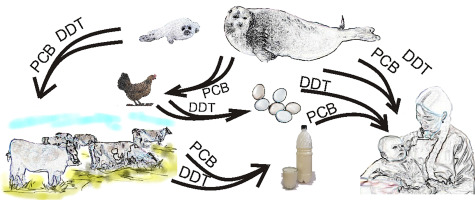当前位置:
X-MOL 学术
›
Sci. Total Environ.
›
论文详情
Our official English website, www.x-mol.net, welcomes your feedback! (Note: you will need to create a separate account there.)
Freshwater seal as a source of direct and indirect increased human exposure to persistent organic pollutants in a background area.
Science of the Total Environment ( IF 9.8 ) Pub Date : 2020-01-27 , DOI: 10.1016/j.scitotenv.2020.136922 Elena A Mamontova 1 , Eugenia N Tarasova 1 , Alexander A Mamontov 1 , Anatoliy M Mamontov 2
Science of the Total Environment ( IF 9.8 ) Pub Date : 2020-01-27 , DOI: 10.1016/j.scitotenv.2020.136922 Elena A Mamontova 1 , Eugenia N Tarasova 1 , Alexander A Mamontov 1 , Anatoliy M Mamontov 2
Affiliation

|
The aim of the study is to investigate POP levels in environmental media (air, snow, soil and sediment), certain food items in the Olkhon district (Irkutsk Region, Russia) and Lake Baikal seal (nerpa) fat and meat in order to define the main pathways of elevated human exposure to POPs in the area. POP levels in soil and air samples and in almost all of the food items from the Olkhon district were comparable to levels in background areas of the Lake Baikal region. Only certain chicken eggs, large fish and blubber of nerpa pups exceeded maximum permissible levels of ΣDDTs and ΣHCHs. The combination of elevated levels of POPs in the Baikal nerpa with the use of Baikal nerpa fat (traditional nutritional habits, feed additives, as well as medicine for humans and domestic animals) results in two pathways for POPs to enter the human body: from seals it enters the human body directly, and indirectly from seals to poultry and livestock and then to the human body. Several scenarios of human exposure to POPs including the incidental ingestion of soil, inhalation of air, and ingestion of food were considered. The largest part of POPs enters the human organism through chicken eggs followed by fish and cow's milk in the scenario without the consumption of nerpa meat and blubber. The high consumption rate of fish as well as the consumption of the fat of nerpa pups or melted fat of nerpa increases the daily intake of POPs 1.3-11 times. The indexes of non-cancer risk and total cancer risk were assessed for residents of the Olkhon district and compared with indexes of risk for the average population of Irkutsk Region. Limiting the use of nerpa fat and meat as food and feed supplement reduces the potential human health risk.
中文翻译:

淡水海豹是人类直接或间接增加本底区域中持久性有机污染物暴露的来源。
该研究的目的是调查环境介质(空气,雪,土壤和沉积物),Olkhon区(俄罗斯伊尔库茨克州)和贝加尔湖海豹(nerpa)中的某些脂肪和肉类中的POP含量,以便确定该地区人类暴露于持久性有机污染物的主要途径。Olkhon地区的土壤和空气样本以及几乎所有食品中的POP含量与贝加尔湖地区背景地区的POP含量相当。只有某些鸡蛋,大型鱼和nerpa幼崽的脂肪超过了允许的最大水平,如ΣDDT和ΣHCH。贝加尔湖nerpa中持久性有机污染物水平的升高与贝加尔湖nerpa脂肪的使用(传统的营养习惯,饲料添加剂以及人类和家畜的药物)共同导致持久性有机污染物进入人体的两种途径:它从海豹直接进入人体,然后从海豹间接进入家禽和牲畜,然后再进入人体。考虑了人类暴露于持久性有机污染物的几种情况,包括土壤的偶然摄入,空气的吸入和食物的摄入。在不消耗nerpa肉和脂肪的情况下,最大一部分持久性有机污染物通过鸡蛋进入人体,然后是鱼和牛奶。鱼的高消费率以及海豹幼崽的脂肪或海豹融化的脂肪的消耗使持久性有机污染物的每日摄入量增加了1.3-11倍。对奥尔洪地区居民的非癌症风险和总癌症风险指标进行了评估,并与伊尔库茨克州平均人口的风险指标进行了比较。
更新日期:2020-01-27
中文翻译:

淡水海豹是人类直接或间接增加本底区域中持久性有机污染物暴露的来源。
该研究的目的是调查环境介质(空气,雪,土壤和沉积物),Olkhon区(俄罗斯伊尔库茨克州)和贝加尔湖海豹(nerpa)中的某些脂肪和肉类中的POP含量,以便确定该地区人类暴露于持久性有机污染物的主要途径。Olkhon地区的土壤和空气样本以及几乎所有食品中的POP含量与贝加尔湖地区背景地区的POP含量相当。只有某些鸡蛋,大型鱼和nerpa幼崽的脂肪超过了允许的最大水平,如ΣDDT和ΣHCH。贝加尔湖nerpa中持久性有机污染物水平的升高与贝加尔湖nerpa脂肪的使用(传统的营养习惯,饲料添加剂以及人类和家畜的药物)共同导致持久性有机污染物进入人体的两种途径:它从海豹直接进入人体,然后从海豹间接进入家禽和牲畜,然后再进入人体。考虑了人类暴露于持久性有机污染物的几种情况,包括土壤的偶然摄入,空气的吸入和食物的摄入。在不消耗nerpa肉和脂肪的情况下,最大一部分持久性有机污染物通过鸡蛋进入人体,然后是鱼和牛奶。鱼的高消费率以及海豹幼崽的脂肪或海豹融化的脂肪的消耗使持久性有机污染物的每日摄入量增加了1.3-11倍。对奥尔洪地区居民的非癌症风险和总癌症风险指标进行了评估,并与伊尔库茨克州平均人口的风险指标进行了比较。



























 京公网安备 11010802027423号
京公网安备 11010802027423号